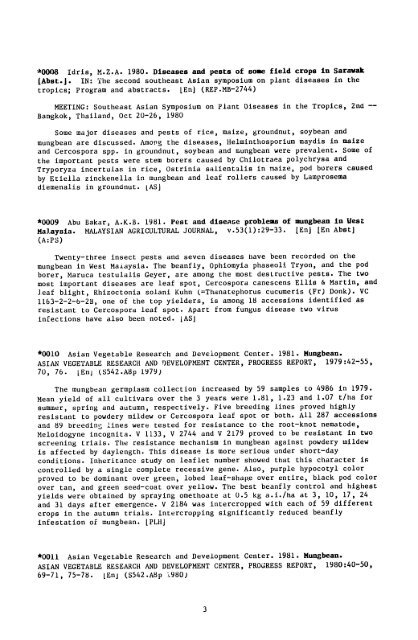PNABD246.pdf
PNABD246.pdf
PNABD246.pdf
You also want an ePaper? Increase the reach of your titles
YUMPU automatically turns print PDFs into web optimized ePapers that Google loves.
*0008 Idris, M.Z.A. 1980. Diseases and pests of some field crops in Sarawak<br />
(Abst.j. IN: The second southeast Asian symposium on plant diseases in the<br />
tropics; Program and abstracts. [En] (REP.MB-2744)<br />
MEETING: Southeast Asian Symposium on Plant Diseases in the Tropics, 2nd --<br />
Bangkok, Thailand, Oct 20-26, 1980<br />
Some major diseases and pests of rice, maize, groundnut, soybean and<br />
mungbean are discussed. Among the diseases, Helminthosporium maydis in maize<br />
and Cercospora spp. in groundnut, soybean and mungbean were prevalent. Some of<br />
the important pests were stem borers caused by Chilotraea polychrysa and<br />
Tryporyza incertulas in rice, Ostrinia salientalis in maize, pod borers caused<br />
by Etiella zinckenella in mungbean and leaf rollers caused by Lamprosema<br />
diemenalis in groundnut. LAS]<br />
*0009 Abu Bakar, A.K.B. 1981. Pest and disease problems of mungbean in West<br />
Malaysia. MALAYSIAN AGRICULTURAL JOURNAL, v.53(i):29-33. [En] [En Abst]<br />
(A:PS)<br />
Twenty-three insect pests and seven diseases have been recorded on the<br />
mungbean in West Maiaysia. The beanfly, Ophiomyia phaseoli Tryon, and the pod<br />
borer, Maruca testulalis Geyer, are among the most destructive pests. The two<br />
most important diseases are leaf spot, Cercospora canescens Ellis & Martin, and<br />
leaf blight, Rhizoctonia solani Kuhn (=Thanatephorus cucumeris (Fr) Donk). VC<br />
1163-2-2-b-2B, one of the top yielders, is among 18 accessions identified as<br />
resistant to Cercospora leaf spot. Apart from fungus disease two virus<br />
infections have also been noted. [AS]<br />
*0010 Asian Vegetable Research and Development Center. 1981. Mungbean.<br />
ASIAN VEGETABLE RESEARCH AND DEVELOPMENT CENTER, PROGRESS REPORT, 1979:42-55,<br />
70, 76. [Enj (S542.A8p 1979)<br />
The mungbean germplasm collection increased by 59 samples to 4986 in 1979.<br />
Mean yield of all cultivars over the 3 years were 1.81, 1.23 and 1.07 t/ha for<br />
summer, spring and autumn, respectively. Five breeding lines proved highly<br />
resistant to powdery mildew or Cercospora leaf spot or both. All 287 accessions<br />
and 89 breeding lines were tested for resistance to the root-knot nematode,<br />
Meloidogyne incognita. V 1133, V 2744 and V 2179 proved to be resistant in two<br />
screening trials. The resistance mechanism in mungbean against powdery mildew<br />
is affected by daylength. This disease is more serious under short-day<br />
conditions. Inheritance study on leaflet number showed that this character is<br />
controlled by a single complete recessive gene. Also, purple hypocotyl color<br />
proved to be dominant over green, lobed leaf-shape over entire, black pod color<br />
over tan, and green seed-coat over yellow. The best beanfly control and highest<br />
yields were obtained by spraying omethoate at 0.5 kg a.i./ha at 3, 10, 17, 24<br />
and 31 days after emergence. V 2184 was intercropped with each of 59 different<br />
crops in the autumn trials. Intercropping significantly reduced beanfly<br />
infestation of mungbean. [PLHJ<br />
*0011 Asian Vegetable Research and Development Center. 1981. Mungbean.<br />
ASIAN VEGETABLE RESEARCH AND DEVELOPMENT CENTER, PROGRESS REPORT, 1980:40-50,<br />
69-71, 75-78. jEnj (S542.A8p 1980)<br />
3

















